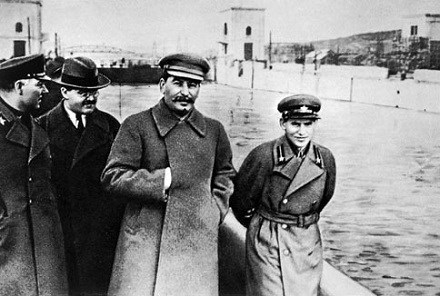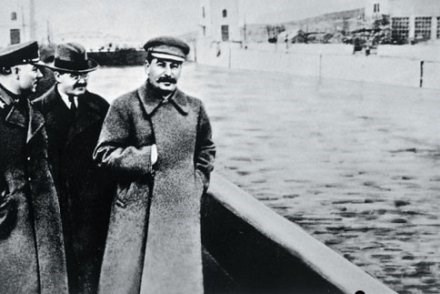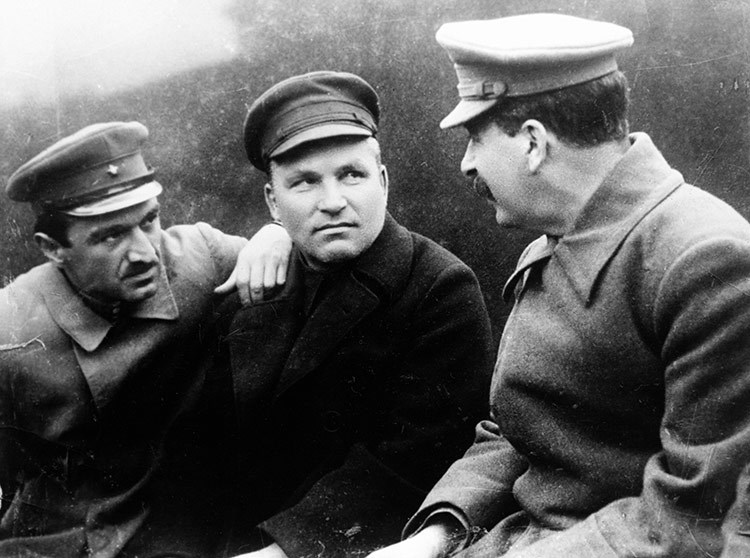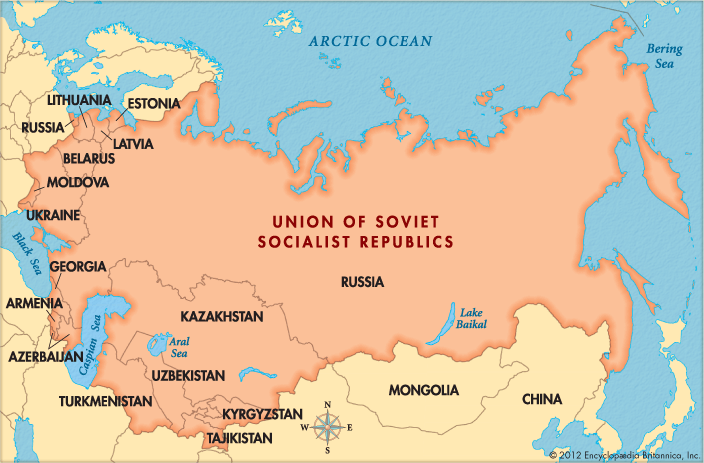11 Week 3: Life and Work in the Soviet Union: Stalin’s Purges and the Gulag
This week, we move on to the experience of life and work in the Soviet Union. One Day in the Life of Ivan Denisovich was a novel written by Aleksandr Solzhenitsyn in 1962. It offers a stark portrayal of life in the Soviet labor camps, known as the Gulag, during the height of Joseph Stalin’s regime. Please read this article introducing Solzhenitsyn, first to get a rough idea of the context in which this novel was written. Compared with The Unbearable Lightness of Being, One Day in the Life of Ivan Denisovich reveals a more extraordinary harsh life that also reflected the harsher treatment of dissidents in the USSR from the 1930s-50s, during a period of Soviet history called “The Great Purge.”

Stalin tightens his grip on the Soviet Union
The 1920s were remembered as a time of relative freedom and experimentation
in the newly formed USSR. Vladimir Lenin’s New Economic
Policy, a retreat from orthodox Marxism, allowed a degree of private
trade, and artists and writers flourished in the country’s major cities. NEP
was meant as a temporary measure to revive the economy after the devastation
of the Russian Civil War and failed attempts at collectivization.
As Lenin’s health declined, the Soviet leadership began to split into factions,
with members of the Politburo jockeying to become Lenin’s successor.
Following his death in 1924, the founders of the Soviet Union formed
competing alliances due to disagreements over Lenin’s New Economic
Policy and other leadership questions. Through shrewd deal-making, Joseph
Stalin emerged the strongest central figure in the power struggle
over the Communist Party, sidelining other potential successors such as
Leon Trotsky. By 1927 Stalin was firmly in control of the party.
Upon becoming the clear leader of the USSR, Stalin began installing loyalists
to leadership positions and expelling opponents, including many of
Lenin’s former allies. Leon Trotsky, once the second-most important theorist
of Soviet dogma after Lenin, was exiled to Central Asia in 1928 and
then forced to leave the USSR in 1929. He was assassinated in 1940.
Stalin began reversing Lenin’s New Economic Policy and forcibly collectivizing
farms throughout the country, leading to a devastating famine in
1932-1933. He also further tightened restrictions on freedom of expression
and implemented a more conservative social policy.
Stalin was known for demonizing anyone he saw as a threat, labeling
them Trotskyites and counter-revolutionaries. Thousands were expelled
from the Communist Party in the early 1930s. In 1936, however, expulsions
accelerated, and perceived opponents were no longer simply ejected
from the party but were also arrested and in many cases executed.


Nikolai Yezhov, the head of the NKVD, was removed from photos following his arrest and execution during the Great Purge.

The assassination of Sergei Kirov (center) was used as the pretext for the launch of the Great Purge.
The Great Purge, 1936-1938
In December 1934 Sergei Kirov, a high-ranking member of the Communist Party, was assassinated in Leningrad. His murder was likely orchestrated by the NKVD at the orders of Stalin, who used the event as a pretext for implementing a number of repressive laws and launching a massive investigation to identify so-called “saboteurs” and “enemies of the people” throughout the party.
In 1936 a series of show trials was held in Moscow. Prominent founders of the Soviet Union and leading members of the Communist Party were convicted of counter-revolutionary activity and executed. The show trials launched a frenzy of arrests, during which hundreds of thousands of people—government officials, party bosses, and members of the military leadership—were detained and executed or sent to forced-labor camps.
More than a third of Communist Party members died during the purges. More than half of the Central Committee was killed. Eighty-one of 103 of the highest-ranking military leaders were executed, a process that crippled the Soviet Union’s ability to defend against Nazi soldiers when Germany invaded in 1941.
Ordinary citizens were affected as well. As the terror spread across society, people were coerced into denouncing their friends, coworkers, and even family members in an attempt to save themselves. Those arrested were often tortured and forced to sign documents confessing to extraordinary crimes and conspiracies. They were labeled enemies of the people and sentenced to death or hard labor.
Millions were sent to prison camps between 1936 and 1938. Many of the camps were located in the far reaches of Siberia or the Russian Far East, where conditions were extreme. Hundreds of thousands died while in Gulag prisons. Forced labor was a feature of Gulag prisons. Gulag—The name given to the network of prisons and work camps throughout the Soviet Union where criminals and political prisoners were sent. In Russian, GULAG is an acronym that stands for “Main Camp Administration.”
The purge strongly affected the USSR’s intelligentsia—academics, artists, musicians, writers, and scientists. Many of the country’s famous writers and artists were arrested and killed, even those who had supported the Bolshevik Revolution. In 1938, near the end of the purge’s most intense period, the head of the NKVD, Nikolai Yezhov, was himself arrested and executed.
The policy of mass execution largely ended by late 1938, but political arrests and repressions continued until Stalin’s death in 1953. Millions remained in prison, and family members were often unable to find out whether their imprisoned relatives were alive. Many were informed that their loved ones had been sentenced to 10 years without the right of correspondence, although many had actually been killed.
Nikita Khrushchev, who came to power in the 1950s following Stalin’s death, reversed many of the most repressive policies. During a secret speech to the Communist Party of the Soviet Union Congress in 1956, Khrushchev denounced Stalin’s purges and his cult of personality. He then began a process of “de-Stalinization” and many Gulag prisoners were slowly released.
In the 1950s and early 1960s, many victims of the purges were “rehabilitated,” a process that meant that the former prisoners were allowed to reclaim their lives and status. However, many were rehabilitated posthumously, since they had been executed during the purges.
Some prominent figures, such as Leon Trotsky, were never rehabilitated. Others were granted amnesty but not rehabilitation.
Conditions at the prisons were largely unknown to the outside world and to those who were unaffected by the purges. Word spread of the brutal conditions when accounts began appearing in the underground press, known as samizdat. One such work, The Gulag Archipelago, written by the former prisoner and dissident writer Aleksandr Solzhenitsyn, became an influential book abroad for its graphic account and circulated in the underground literary scene of the Soviet Union for decades.
Questions to consider
Here are some questions you can keep in mind when reading “One Day in the Life of Ivan Denisovich” to guide you for the note-taking assignment.
- How does Solzhenitsyn’s portrayal of the Gulag system in “One Day in the Life of Ivan Denisovich” inform you about Soviet labor camps during the Stalinist era?
- Discuss the role of individual agency and resistance in the face of oppression as depicted in the novel. How do Ivan Denisovich and other prisoners assert their humanity and preserve their dignity within the dehumanizing confines of the Gulag?
- Analyze the significance of the novel’s narrative structure, which spans a single day in the life of Ivan Denisovich. How does this temporal scope contribute to our understanding of the overall experience of the Gulag?
- Solzhenitsyn portrays a variety of characters in the novel, each with their own unique responses to the challenges of the Gulag. Compare and contrast the different coping mechanisms employed by characters such as Alyosha, Fetyukov, and Tsezar. What do their approaches reveal about the diversity of human responses to extreme circumstances?
- The novel provides vivid descriptions of the physical conditions and labor in the Gulag. How do these descriptions contribute to our understanding of the economic and social dimensions of the Soviet labor camp system?
- Discuss the role of power and authority in the novel. How are the prisoners subjected to different forms of power, both from the camp administration and from their fellow inmates? How does this impact the dynamics of the prison community?
- Explore the representation of the guards and camp administrators in the novel. How are they depicted? What does their portrayal reveal about the relationship between the oppressors and the oppressed in the Gulag?
- Reflect on the significance of the novel’s publication during the Khrushchev Thaw, a period of relative political openness and cultural relaxation in the Soviet Union. How did the publication and reception of “One Day in the Life of Ivan Denisovich” contribute to the wider discussion of Soviet history and the memory of the Gulag?
- Solzhenitsyn’s work was highly controversial in the Soviet Union, and he faced criticism and censorship. Discuss the potential impact of “One Day in the Life of Ivan Denisovich” as a form of resistance literature and its influence on public perceptions of the Gulag system.
- Consider the historical legacy of “One Day in the Life of Ivan Denisovich” beyond the context of the Soviet Union. How has the novel contributed to our understanding of totalitarian regimes, human rights abuses, and the resilience of the human spirit in the face of oppression?

